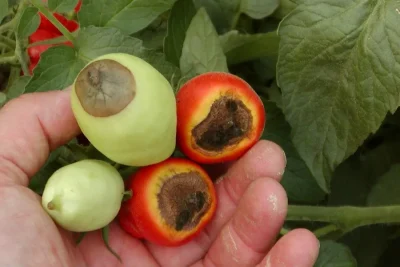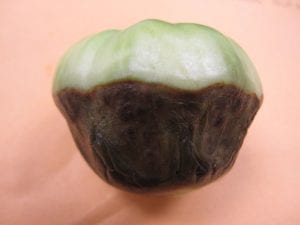Tomato Blossom End Rot
Author: Matthew DeBacco
Reviewed by: Shuresh Ghimire, Ph.D.
Associate Extension Educator
Extension Vegetable Specialist
Date of Publication: July 28, 2025
Introduction
Blossom end rot (BER) is a physiological disorder caused by a localized calcium deficiency in developing fruit. However, early symptoms may look like a disease. The name comes from the area on the fruit, the blossom end, that will show the dark brown/black lesion. This can cause the tomato not to fill out completely resulting in not only visually unappealing fruit, but could also provide an area for other pathogens to enter and for rot to start. Be aware that this is not limited to tomatoes as this can also occur in peppers, eggplant, and cucurbits.


Symptoms
Looking at the blossom end of the immature fruit initially small brown spots will be seen that will enlarge and converge to result in a brown to black lesion that could cover half of the fruit. If it is only BER the tissue will feel thin and papery, but if upon inspection it is soft there is likely a secondary infection that has already invaded the tissue. Growers are most likely to find this on the first truss of the plant or when fruit ripening is at an accelerated rate.
Note: The plant will rarely exhibit any visual signs of an issue, but plant stresses such as drought, high temperatures can increase the chance of BER. In extreme calcium deficiency in a plant, the newer (upper) growth will have small brown lesions that can lead to die back, but this is not commonly seen.
Host Crops: Solanaceae family (Tomatoes, Peppers, Eggplant) and Cucurbits
Identification of Disease
Blossum end rot (BER) is the result of insufficient calcium uptake and/or transport to the developing fruit. Since the blossom end is the furthest physical distance from the stem the calcium is most likely to run out before reaching the blossom end which is why the lesion appears in the region of the fruit.
Not to be confused with:
- Anthracnose - can infect leaves and stems, lesions tend to form concentric rings
- Bacterial Spot - smaller lesions can infect leaves, not localized to blossom end
- Catfacing - Irregular tissue formation and not an irregular discoloration
- Sunscaled - more commonly found in the upper or sun exposed tissue
Transmission/Vectors
As this is a physiological disorder, this does not transfer from one plant to another.
Management
The key to managing BER is to feed the soil to allow more efficient saturation of plant tissue. Calcium foliar sprays should only be used in the case that a deficiency is seen to help lessen the rate of progression.
Variety Selection
In general most cherry tomato varieties are less susceptible to BER. Additional varieties of tomatoes with greater resilience include Celebrity, Fresh Pak, Jet Star, Mountain Pride, and Early Girl.
Cultural
- Maintain even and consistent soil moisture, providing 1–2 inches of water per week.
- Get a soil test before planting to ensure adequate calcium and pH levels (pH 6.2–6.8 is ideal for calcium availability). Add gypsum, or calcium-rich amendments (see below) if deficient. If tomatoes are showing signs of calcium deficiency, lime is not a quick fix but will raise the soil pH. So only add lime to adjust pH and not to supplement calcium.
- Avoid excessive nitrogen fertilizers as this can reduce calcium uptake
- Spray products, such as Botanicare Cal-Mag Max and Bio-min Calcium (OMRI listed) can be applied to correct the deficiency.
References
Austin, D. (2020, April 17). Blossom end rot on tomatoes. UF/IFAS Extension Highlands County. https://blogs.ifas.ufl.edu/highlandsco/2020/04/17/blossom-end-rot-on-tomatoes/
Butzler, T. (2022, October 9). Blossom end rot, internal whitening, and rain check of tomatoes. Penn State Extension. https://extension.psu.edu/blossom-end-rot-internal-whitening-and-rain-check-of-tomatoes
Cornell University. (n.d.). Blossom end rot (fruit disorder) on tomatoes. Cornell University, Long Island Horticultural Research & Extension Center. https://blogs.cornell.edu/livegpath/gallery/tomato/blossom-end-rot-fruit-disorder-on-tomatoes/
Jagger, C. (2022, July 15). Blossom end rot of tomatoes and peppers. The Ohio State University, Fairfield County Extension. https://u.osu.edu/gofarmohio/2022/07/15/blossom-end-rot-of-tomatoes-and-peppers/
University of Minnesota Extension. (n.d.). Bacterial canker of tomato. https://extension.umn.edu/disease-management/bacterial-canker-tomato
Consult and follow pesticide labels for registered uses. To avoid potential phytotoxicity problems, spot test before widespread use.
No discrimination is intended for any products not listed.
The information in this document is for educational purposes only. The recommendations contained are based on the best available knowledge at the time of publication. Any reference to commercial products, trade or brand names is for information only, and no endorsement or approval is intended. UConn Extension does not guarantee or warrant the standard of any product referenced or imply approval of the product to the exclusion of others which also may be available. The University of Connecticut, UConn Extension, College of Agriculture, Health and Natural Resources is an equal opportunity program provider and employer.